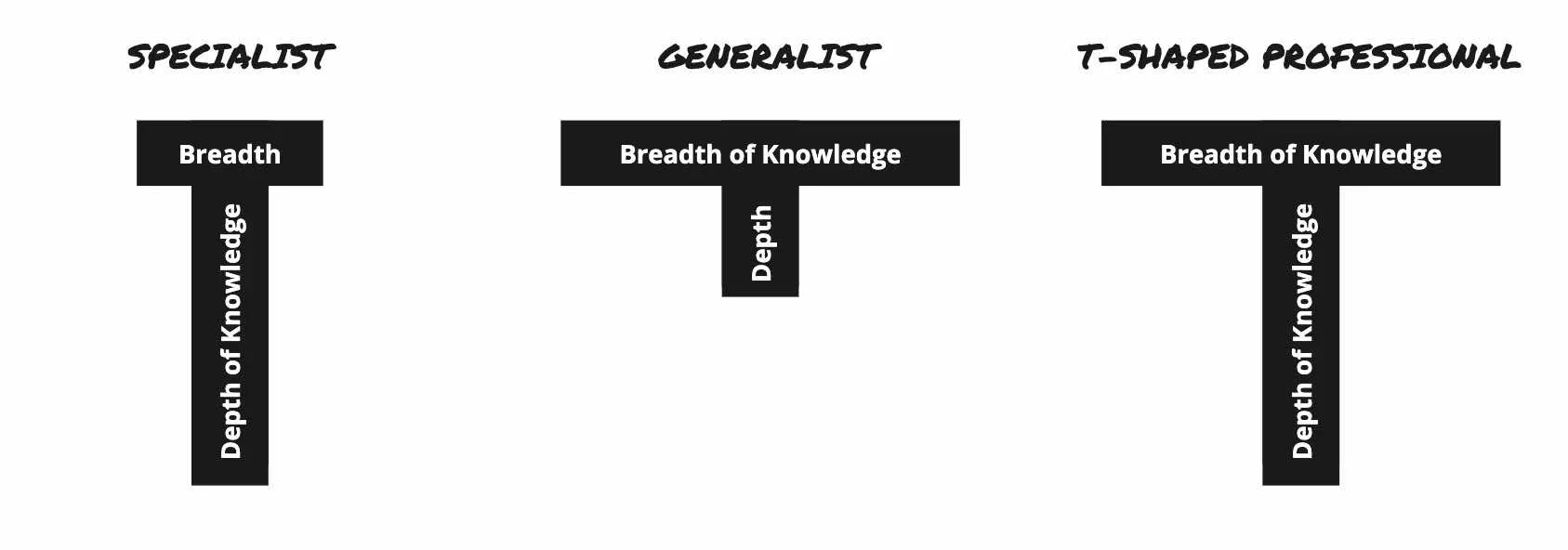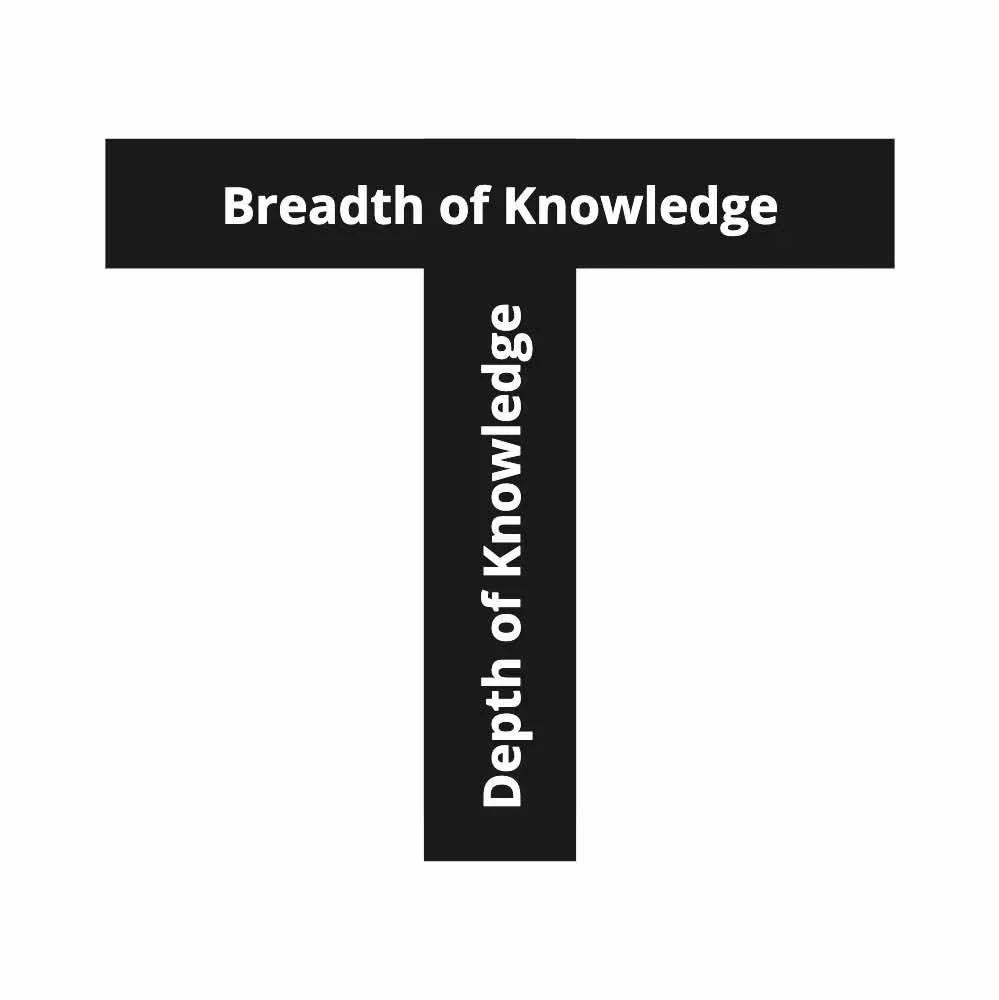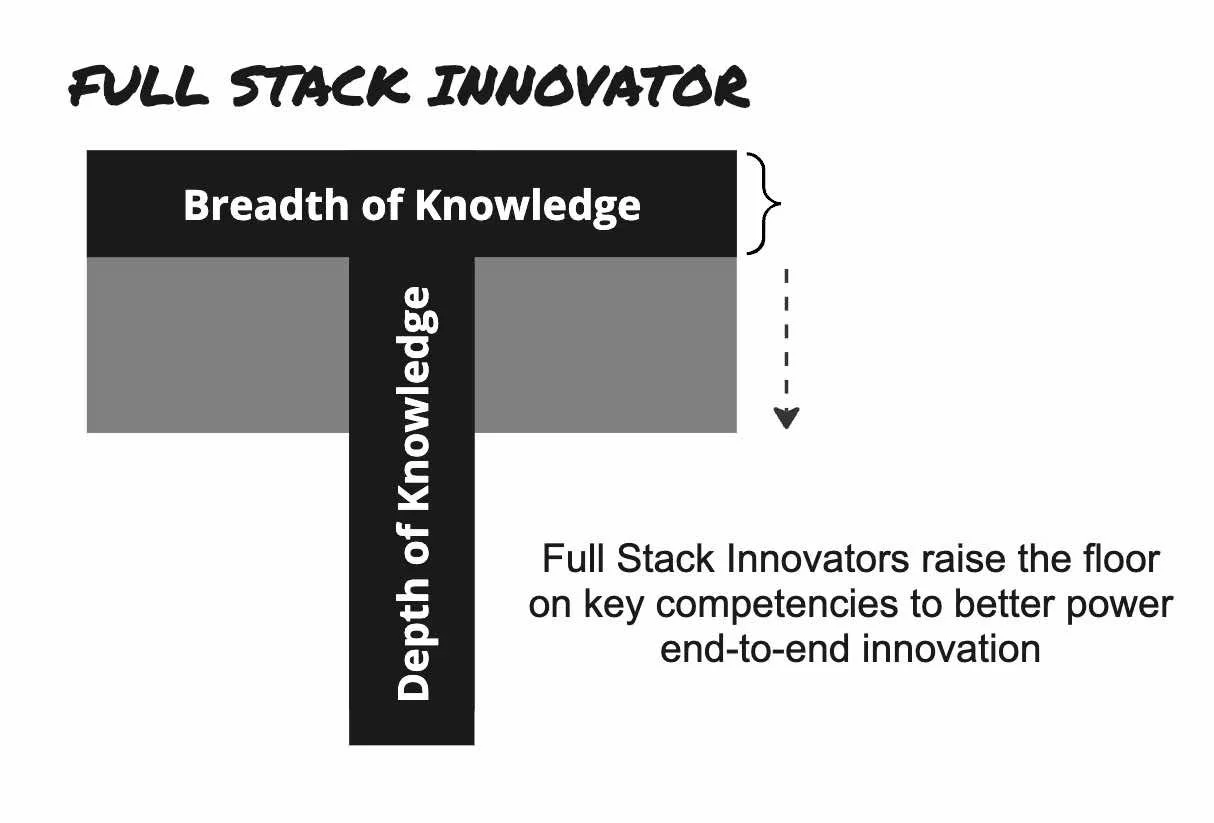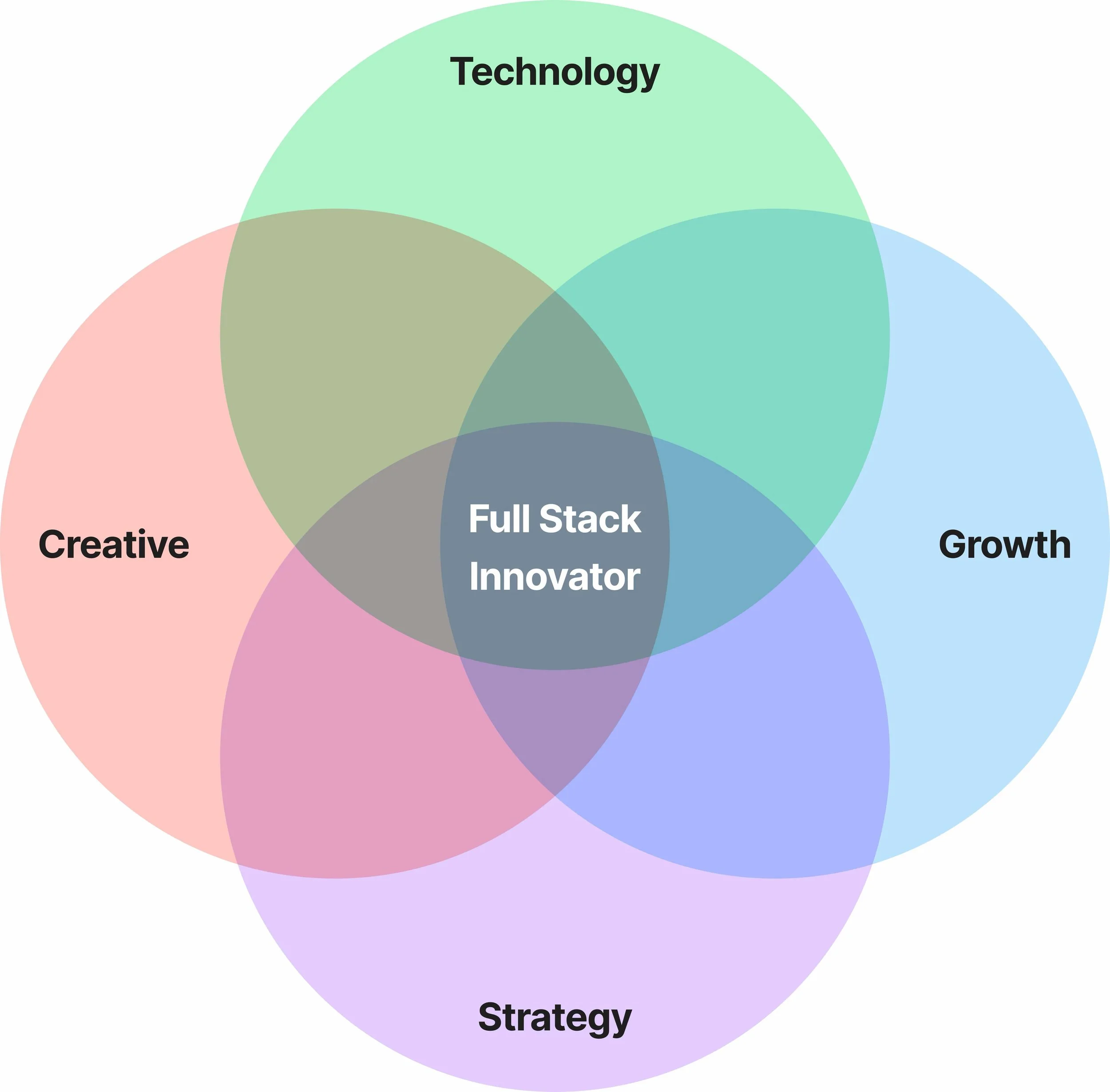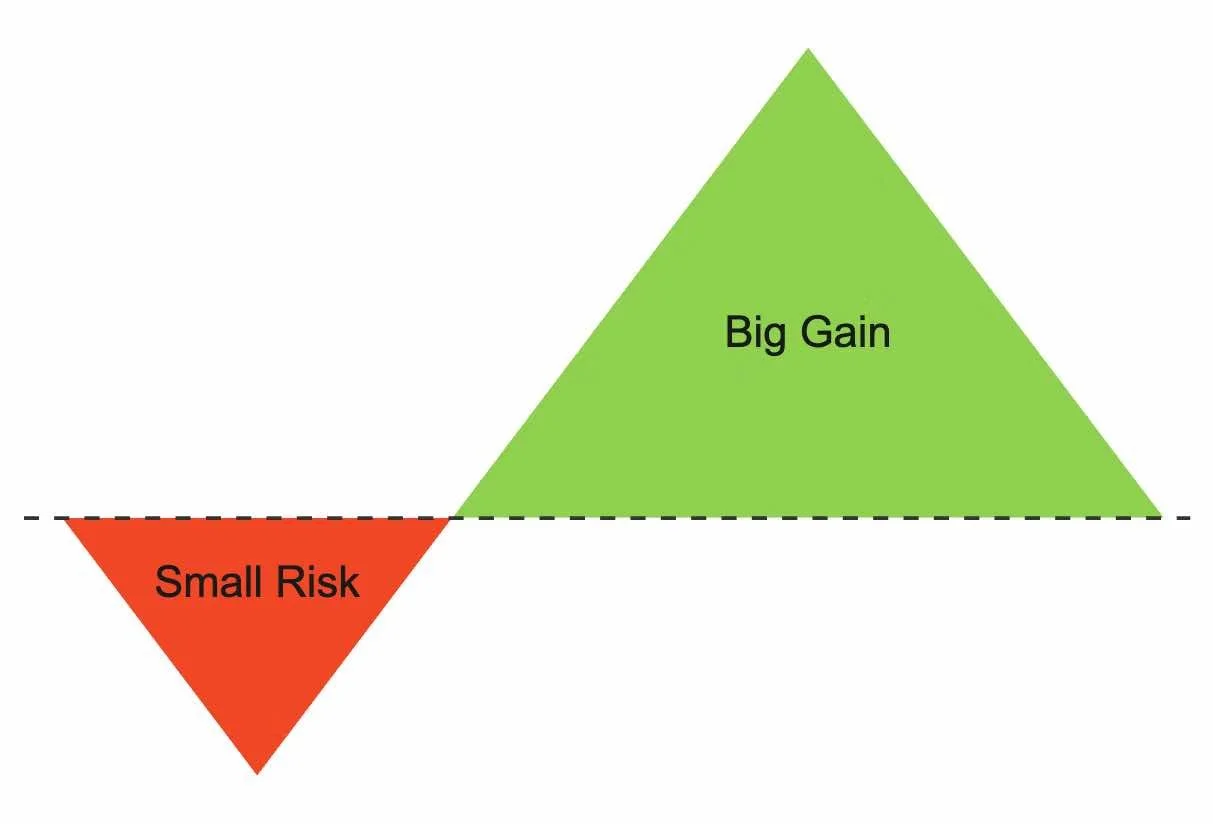Full Stack Innovator Course: Lesson 1.2 (Free Preview)
On This Page
My Full Stack Innovator course is free through October
Become an Augmented Generalist in the AI era with this comprehensive 21-lesson journey into innovation.
This is Lesson 1.2 from my Full Stack Innovator curriculum in the Pioneer’s Clubhouse.
Our Value As A Unique "Specialized Generalist"
Learning Objective: By the end of this lesson, you will be able to distinguish the unique value proposition of Full Stack Innovators compared to other innovation-related roles, and articulate how this holistic skillset / approach enables this kind of professional to drive impact across the innovation lifecycle.
Full Stack Innovators can explain technical constraints to designers, convey user insights to engineers, and frame business objectives for creatives. By ensuring that everyone is aligned and speaking the same language, Full Stack Innovators help break down silos and foster a more integrated approach to innovation.
Introduction
In Lesson 1.1, we explored the core characteristics and competencies that define a Full Stack Innovator, from their multidisciplinary mastery and adaptive agility to their systems thinking mindset and innovative spirit. We saw how these attributes set Full Stack Innovators apart as the vanguards of the 21st century innovation landscape, equipped to tackle complex challenges and drive meaningful change.
Building on this foundation, Lesson 1.2 goes deeper into the unique value proposition of Full Stack Innovators, and how they differentiate themselves from other archetypes in the innovation ecosystem.
We'll examine the specific ways in which Full Stack Innovators combine and transcend the capabilities of specialists and generalists, and how they catalyze and orchestrate innovation efforts in powerful ways.
Navigating the Innovation Landscape
As we saw in Lesson 1.1, the landscape of innovation is becoming increasingly complex and multifaceted, with exponential technologies like AI democratizing problem-solving capabilities and driving a shift towards decentralized innovation.
In this context, the traditional boundaries between disciplines and domains are blurring, and the most impactful solutions often emerge at the intersections.
This is the playground of the Full Stack Innovator - a dynamic and fluid space where we can leverage our multidisciplinary expertise and boundary-spanning abilities to connect the dots and drive holistic innovation.
But to fully appreciate our unique value as an individual or on a team, it's helpful to situate this context within the broader ecosystem of innovation archetypes.
At a high level, we can think of three main types of innovators:
Specialists: Deep experts in a particular domain, whether it's a technical focus or a non-technical discipline like design, strategy, etc. Specialists bring a depth of knowledge and prowess to innovation efforts, but may struggle to translate their expertise across domains or see the bigger picture.
Generalists: Jack-of-all-trades who have a breadth of knowledge across multiple domains, but may lack depth in any one area. Generalists excel at seeing connections and patterns, but may struggle to drill down into the technical nitty-gritty or drive tangible outcomes.
Full Stack Innovators: Master integrators who combine the depth of specialists with the breadth of generalists, and layer on a unique set of boundary-spanning, systems thinking, and leadership capabilities. Full Stack Innovators excel at navigating across domains, orchestrating diverse teams and perspectives, and driving end-to-end innovation from concept to execution.
The idea of a T-Shaped Professional encapsulates this full stack DNA in a lot of ways. The T-Shape is in reference to maintaining a breadth of essential knowledge while having a depth of knowledge in a particular area.
In most cases, being T-Shaped is the smartest way to go about becoming a person of impact in an organization. (And to becoming a well-rounded thinker, too!)
However, in my opinion the Full Stack Innovator is someone who (in addition to maintaining a depth of knowledge in key areas) also elects to raise the floor on key soft and hard skills with cross-disciplinary knowledge.
In becoming a Full Stack Innovator, we are still T-Shaped but we have more depth in our breadth, specifically across the competency profile outlined in Lesson 1.1.
While specialists and generalists certainly have their place in the innovation ecosystem, we full stackers are the ones uniquely equipped to stitch together the patchwork of skills and perspectives into cohesive and impactful solutions.
We are like the conductors of the innovation orchestra, ensuring that all the different instruments are playing in harmony and building towards a shared crescendo.
The Symphony of Skills
So what exactly makes this unique role so effective at orchestrating innovation?
At the core, it's an ability to fluidly combine and transcend the capabilities of both specialists and generalists across domains, and bring to bear a potent mix of technical, strategic, and interpersonal skills.
We are a highly dynamic synapse in the "brain" of an organization.
On the technical front, Full Stack Innovators have the depth of expertise needed to understand and leverage emerging technologies like AI, blockchain, or AR/VR. We can roll up our sleeves and get into the weeds of data analysis, software development, or product design, and speak the language of the specialists.
But we also layer in strategic business acumen and a customer-centricity that allows us to translate technical capabilities into meaningful value propositions and go-to-market strategies. We understand the broader industry and market context in which we operate, and can anticipate and navigate the complex stakeholder landscape.
Moreover, we bring the human touch of a creative and a design thinker to our work, and we don't find ourselves pressed when faced with dynamic, ambiguous challenges. Plus, we really understand people – this empathy translates into a something like a "Spidey Sense" for user needs and a talent for building, leading, or inspiring diverse teams. Our presence can be like a rock in turbulent waters, helping to resolve conflicts and create the conditions for collaborative creativity to flourish.
It's this symphony of skills - technical and strategic, analytical and creative, individual and interpersonal - that allows Full Stack Innovators to architect innovation solutions that are more than the sum of their parts.
TL;DR: We are both the "glue" that holds together the disparate pieces of the innovation puzzle and the "gas" that can make the engine go.
Systems Thinking in Action
Another key differentiator of FSIs is the ability to apply systems thinking to complex innovation challenges.
As we touched on in Lesson 1.1, systems thinking is about zooming out to see the big picture and understanding how different elements of a system interact and influence each other.
If you've ever found yourself saying "They're fixing a symptom, not the real problem... If they fixed XYZ instead, it would actually solve the issue", then you're probably a systems thinker.
For Full Stack Innovators, this means being able to map out the intricate web of stakeholders, processes, and technologies involved in any given innovation challenge, and identify the key leverage points for intervention.
Yes, we really like leverage and we are keenly attuned to the upside of asymmetric opportunities. In other words, we can easily see the low-risk, low-hanging fruits that offer exponential gains with minimal downside.
We can see how a change in one part of the system might have ripple effects across the entire ecosystem, and design solutions that anticipate and adapt to these dynamics.
For example, consider a Full Stack Innovator tasked with developing a new digital health platform to support patients with chronic conditions. Rather than diving straight into the technical architecture or UI design, they would start by mapping out the broader healthcare system in which the platform will operate.
They would consider the needs and pain points of not just the patients, but also the providers, payers, and policymakers involved in their care journeys. They would examine how the platform might integrate with or disrupt existing clinical workflows, reimbursement models, and regulatory frameworks. And they would anticipate how the introduction of the platform might shift power dynamics and incentives among different stakeholders.
By taking this systems-level view, the Full Stack Innovator can design a solution that not only meets the immediate needs of patients, but also drives broader transformation and value creation across the healthcare ecosystem. They can identify opportunities for partnerships and collaboration, anticipate and mitigate potential risks and unintended consequences, and build the buy-in and alignment needed for successful adoption and scale.
This ability to zoom out and connect the dots is what allows Full Stack Innovators to tackle the most complex and entrenched challenges of our time, from climate change and social inequality to healthcare access and educational equity.
We bring a holistic and multi-disciplinary lens to problems that are resistant to siloed or incremental solutions.
Catalyzing and Scaling Impact
Ultimately, the unique value of Full Stack Innovators lies in their ability to catalyze and scale innovation impact across organizations and ecosystems. They are the spark plugs of innovation, igniting new ideas and possibilities, and the engines of execution, driving solutions from concept to reality.
One of the key ways that Full Stack Innovators catalyze innovation is by serving as powerful conveners and translators across different stakeholder groups. With their ability to speak multiple disciplinary languages and build bridges across silos, they can bring together diverse perspectives and facilitate the kind of creative collision that leads to breakthrough ideas.
For example, a Full Stack Innovator working on a smart city initiative might convene a cross-sector working group that includes urban planners, technology vendors, community organizers, and government officials. They would create the space and structure for these different stakeholders to share their unique needs and insights, and facilitate the co-creation of a shared vision and roadmap for the initiative.
But Full Stack Innovators don't just catalyze new ideas - they also excel at driving the end-to-end execution needed to bring these ideas to life. With their mix of technical chops and strategic savvy, they can navigate the complex landscape of prototyping, testing, and scaling new solutions.
They are adept at building and leading the cross-functional teams needed to drive innovation projects forward, from designers and developers to business analysts and marketers. And they have the resilience and adaptability to pivot and persevere in the face of the inevitable challenges and setbacks that come with any innovation journey.
Perhaps most importantly, Full Stack Innovators are masters at storytelling and influence, able to build the narratives and coalitions needed to secure buy-in and resources for their initiatives. They can paint a compelling vision of the future, ground it in data and examples, and enroll others in bringing that vision to life.
It's this combination of catalytic and executional leadership that allows Full Stack Innovators to drive outsized impact and change. They are the ones who can not only imagine a better future, but also rally the troops and lead the charge to make it a reality.
Cultivating Full Stack Innovation
As we've seen throughout this lesson, the unique value of Full Stack Innovators stems from their ability to transcend and integrate the capabilities of specialists and generalists, apply systems thinking to complex challenges, and catalyze and scale innovation impact.
But as we touched on in Lesson 1.1, becoming a Full Stack Innovator is not about being born with some innate genius or superpower. Rather, it's about intentionally cultivating a set of skills, mindsets, and experiences over time - a journey of continuous learning and growth.
So how can aspiring innovators cultivate their full stack potential? Here are a few key strategies:
Develop T-shaped expertise: Cultivate deep expertise in one or more technical domains, while also building breadth across other relevant fields. Become a master of your craft, but also a student of the bigger picture.
Seek out diverse experiences: Take on projects and roles that expose you to different parts of the innovation lifecycle and ecosystem. Work across different industries, geographies, and stakeholder groups to broaden your perspective and network.
Practice systems thinking: Train yourself to zoom out and see the interconnections and interdependencies in any given problem space. Use tools like system mapping and causal loop diagramming to visualize and analyze complex ecosystems.
Build your emotional intelligence: Develop your empathy, communication, and collaboration skills to be able to work effectively with diverse teams and stakeholders. Practice active listening, conflict resolution, and inclusive leadership.
Experiment and iterate: Embrace a bias towards action and experimentation, and view failure as a learning opportunity. Prototype early and often, gather feedback and data, and iterate your way forward.
Tell compelling stories: Hone your ability to craft narratives and pitches that inspire and mobilize others. Use data and examples to build credibility, but also tap into emotion and imagination to paint a picture of what's possible.
Of course, cultivating full stack innovation skills is not just an individual journey - it's also about creating the organizational and ecosystem conditions that enable Full Stack Innovators to thrive. This means breaking down silos and creating cross-functional collaboration structures, providing resources and support for experimentation and risk-taking, and celebrating and scaling the successes of Full Stack Innovators.
Conclusion
In a world of accelerating change and complexity, the unique value of Full Stack Innovators has never been more critical. These master integrators and orchestrators of innovation bring a potent combination of skills and mindsets that allows them to navigate across domains, tackle complex systems-level challenges, and drive meaningful impact at scale.
As we've explored in this lesson, Full Stack Innovators differentiate themselves by transcending and combining the capabilities of specialists and generalists, applying systems thinking to connect the dots and see the bigger picture, and catalyzing and leading the end-to-end innovation process from concept to execution.
For organizations and ecosystems looking to stay ahead of the curve and drive transformative change, cultivating and empowering Full Stack Innovators should be a top priority. These boundary-spanners and bridge-builders are the key to unlocking the kind of holistic, adaptive, and impactful innovation that our rapidly changing world demands.
And for individuals looking to make their mark and create outsized value, developing full stack innovation skills is a powerful way to position yourself for success in the 21st century. By intentionally building your technical, strategic, and interpersonal capabilities, and seeking out diverse experiences and challenges, you can become the kind of innovator that can not only imagine a better future, but also make it a reality.
So as we wrap up this deep dive into the unique value of Full Stack Innovators, I invite you to reflect on your own journey and potential as a full stack innovator. What are your unique strengths and superpowers? Where do you have room to grow and stretch? What kind of impact do you want to have on the world?
The path to full stack innovation is not an easy one, but it is an incredibly rewarding and impactful one. By embracing the challenges and opportunities ahead, and continuing to learn and grow with a beginner's mindset, you can cultivate your own full stack potential and become a catalyst for transformative change.
The world needs more Full Stack Innovators - are you ready to answer the call?
